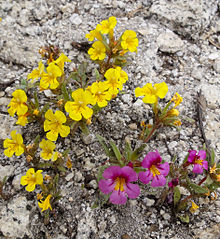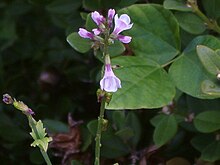Juggler flower plants
| Juggler flower plants | ||||||||||||
|---|---|---|---|---|---|---|---|---|---|---|---|---|

|
||||||||||||
| Systematics | ||||||||||||
|
||||||||||||
| Scientific name | ||||||||||||
| Phrymaceae | ||||||||||||
| shower |
The juggler flower family (Phrymaceae) are a family of plants in the order of the mint family (Lamiales). Few species are used as ornamental plants .
description

Habit and leaves
Most types are annual to perennial herbaceous plants . Only a few species are subshrubs that have a woody base. Many species form rhizomes as persistence organs. The Australian Glossostigma species are hardly larger than duckweed ( Lemna ). The above-ground parts of the plant can be hairless or hairy. The leaves are opposite .
Inflorescence and flowers
The flowers are lateral or terminal, individually or in racemose inflorescences .
The hermaphrodite, zygomorphic flowers are usually five-fold. The green sepals are fused and durable. The petals are fused tube to bell-shaped and the corolla tube ends in two corolla lips. There are usually four (rarely two) stamens present. Usually two carpels are a top permanent ovary grown. The scar is usually broad and bilobed, rarely just two columns or simple.
Fruits and seeds
There are fruit capsules formed, the tiny seeds contain.
Sets of chromosomes
The basic chromosome number is n = 7-12, 14-16, 22 etc.
Systematics and distribution
The Phrymaceae family was established by Johannes Conrad Schauer in 1847 in the work Prodromus Systematis Naturalis Regni Vegetabilis , Volume 11, p. 520, begun by Augustin-Pyrame de Candolle . The type genus is Phryma L. , it used to be the only genus of the Phrymaceae family.
The genera, which were classified in this family on the basis of molecular genetic data in this century, systematists counted earlier to the family of figwort plants (Scrophulariaceae). The data are not yet sufficient to confirm the monophyly of the Phrymaceae family. Some genera may belong to Linderniaceae . It was controversial whether the genera Dodartia , Lancea and Mazus are in a subfamily Mazoideae or even a separate family Mazaceae Reveal . In this century, several genres were rearranged in their scope.
The Phrymaceae family is more or less represented worldwide. The family has two centers of diversity in the temperate and western areas of North America and Australia . There are only a few species in the humid tropics. Some species are also found in eastern North America, in South America, in East and South Asia or in South Africa . In Central Europe , two species of mimulus are naturalized ( neophytes ).
The family Phrymaceae contains 13 (up to 21) genera with about 188 (up to 234) species :
- Bryodes Benth. (Perhaps belongs to Linderniaceae ): The one to three species occur on the Mascarene Islands and in Madagascar .
-
Bythophyton Hook. f. : It contains only one type:
- Bythophyton indicum (Hook. F. & Thomson) Hook. f. : This submerged aquatic plant is common in the Indomalay region.
-
Dintera Stapf : It contains only one species:
- Dintera pterocaulis Stapf : It is widespread in tropical Africa.
- Diplacus Nutt. (Syn .: Eunanus Benth. , Mimulus sect. Diplacus (Nutt.) Benth. & Hook. F. , Mimulus subg. Schizoplacus A.L. Grant ): It was previously assigned to Mimulus and contains around 46 species.
- Elacholoma F. Muell. & Tate : The two species have been found in Australia since 2012:
-
Encopella Pennell (Syn .: Encopa Griseb. ): It contains only one species:
- Encopella tenuifolia (Griseb.) Pennell : It only occurs in Cuba .
- Erythranthe Spach (it was previouslyplaced under Mimulus ): It used to contain around 12 species, and 111 species have belonged to this genus since 2012.
- Glossostigma Wight & Arn. (Syn .: Tricholoma Benth. ): The approximately five species occur in India , Australia and New Zealand .
- Hemichaena Benth. (Syn .: Berendtia A. Gray , Berendtiella Wettstein ): The five or so species are common in Central America .
-
Leucocarpus D.Don : It contains only one species:
- Leucocarpus perfoliatus (Kunth) Benth. : It is common in the Neotropics .
-
Microcarpaea R.Br. : There are only two types:
- Microcarpaea agonis A.R.Bean : It occurs only in the Australian state of Queensland. It was first described in 1997.
- Microcarpaea minima (KDKoenig ex Retz.) Merr. : It is distributed from East Asia to islands in the Pacific. It thrives in swampy locations.
-
Mimetanthe Greene : It contains only one species:
- Mimetanthe pilosa (Benth.) Greene : It occurs in North America.
- Juggler flowers ( Mimulus L. , Syn .: Cynorrhynchium J.Mitchell , Monavia Adanson ): Depending on the author, 7 or 150 to 170 species originally distributed in the New World , Asia and South Africa. Three types are neophytes in Europe.
- Peplidium Delile : The four or so species are distributed in Asia, Africa and Australia.
-
Phryma L .: It contains only one species:
- Phryma leptostachya L .: It is very widespread in North America , Eastern Siberia , Japan , Korea, China, Nepal , India and Western Pakistan .
-
Psammetes Hepper : It contains only one species:
- Psammetes madagascariensis (Bonati) Eb. Fish. & Hepper : It occurs in Madagascar and Nigeria .
-
Thyridia W. R. Barker & Beardsley : This genus, established in 2012, contains only one species:
- Thyridia repens (R.Br.) WRBarker & Beardsley (Syn .: Mimulus repens R.Br. ): It occurs in Australia and New Zealand.
- Uvedalia R.Br. (formerly in Mimulus ): The only two species are found in Australia, Timor and perhaps Papua New Guinea.
The Mazaceae Reveal family, newly established in 2011, includes three genera that previously belonged to the Phrymaceae family:
-
Dodartia L .: It contains only one species:
- Dodartia orientalis L .: It is distributed in southern Russia , Kazakhstan and in Southwest Asia to Central Asia.
- Lancea Hook. f. & Thomson : The only two types are found in India , Bhutan , Sikkim , Mongolia and China .
- Mazus Lour. : The 25 to 30 species are native to Asia , Australia and New Zealand. Individual species are neophytes in North America, Jamaica and Scotland.
swell
- The family of Phrymaceae in APWebsite . (Sections systematics and description)
- PM Beardsley, RG Olmstead: Redefining Phrymaceae: the placement of Mimulus, tribe Mimuleae, and Phryma. In: American Journal of Botany , Volume 89, 2002, pp. 1093-1102: Volltext-online.
- Bastian Schäferhoff, Andreas Fleischmann, Eberhard Fischer, Dirk C. Albach, Thomas Borsch, Günther Heubl, Kai F. Müller: Towards resolving Lamiales relationships: insights from rapidly evolving chloroplast sequences. In: BMC Evolutionary Biology , 2010, 10, 352. doi: 10.1186 / 1471-2148-10-352
- WR Barker, GL Nesom, PM Beardsley, NS Fraga: A taxonomic conspectus of Phrymaceae: A narrowed circumscription for Mimulus, new and resurrected genera, and new names and combinations. In: Phytoneuron , Volume 39, May 16, 2012, pp. 1-60. ISSN 2153-733X full text PDF.
Individual evidence
- ↑ a b c d e f The Phrymaceae family at the AP website .
- ↑ First publication scanned at biodiversitylibrary.org .
- ↑ a b c Bastian Schäferhoff, Andreas Fleischmann, Eberhard Fischer, Dirk C. Albach, Thomas Borsch, Günther Heubl, Kai F. Müller: Towards resolving Lamiales relationships: insights from rapidly evolving chloroplast sequences. In: BMC Evolutionary Biology , 2010, 10, 352. doi: 10.1186 / 1471-2148-10-352
- ↑ a b c d e f g h i j k l m n o p q r s t u v WR Barker, GL Nesom, PM Beardsley, NS Fraga: A taxonomic conspectus of Phrymaceae: A narrowed circumscription for Mimulus, new and resurrected genera, and new names and combinations. In: Phytoneuron , Volume 39, May 16, 2012, pp. 1-60. ISSN 2153-733X full text PDF.
- ↑ Phrymaceae in the Germplasm Resources Information Network (GRIN), USDA , ARS , National Genetic Resources Program. National Germplasm Resources Laboratory, Beltsville, Maryland.
- ^ A b c David John Mabberley: Mabberley's Plant-Book. A portable dictionary of plants, their classification and uses. 3. Edition. Cambridge University Press, 2008, ISBN 978-0-521-82071-4 ( limited preview in Google Book Search).
- ↑ Walter Erhardt , Erich Götz, Nils Bödeker, Siegmund Seybold: The great zander. Encyclopedia of Plant Names. Volume 2. Types and varieties. Eugen Ulmer, Stuttgart (Hohenheim) 2008, ISBN 978-3-8001-5406-7 .
- ↑ JL Reveal: Summary of recent systems of angiosperm classification. In: Kew Bulletin , Volume 66, 2011, pp. 5-48.
- ↑ Angiosperm Phylogeny Group: An update of the Angiosperm Phylogeny Group classification for the orders and families of flowering plants: APG IV. In: Botanical Journal of the Linnean Society , Volume 181, Issue 1, 2016, pp. 1-20. doi : 10.1111 / boj.12385
Web links
- The family Phrymataceae s. st. at DELTA by L. Watson & MJ Dallwitz. (with only one genus)







